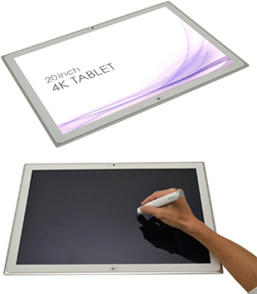
Panasonic Develops 56-inch 4k2k OLED Panel, 20-inch 4k IPS Tablet
Panasonic has developed a 56-inch organic light-emitting diode (OLED) panel with 4k2k resolution (3,840 x 2,160 resolution, 8.29 million pixels), through the "RGB all-printing method."
The Japanese company also today announced the development of a new tablet computer that features a 20-inch IPS Alpha LCD panel with more than four times the resolution of Full High Definition, as well as a high precision digital pen.
In the printing method of production of OLED panels, OLED materials are applied to the substrate through a printing technique to form an electroluminescent (EL) layer. Due to the simplicity of the production process, it is expected that the technology will be easily adaptable to the production of OLED panels in a variety of screen sizes. Through the printing method, it is also possible to apply just the right amount of organic material to where it is needed, reducing waste material and shortening production lead time, making the printing method of production more economical.

 In the production of the OLED panel, Panasonic is utilizing the RGB all-printing method, which allows for the separate application of the red, green and blue OLED materials by means of printing, and has developed the equipment and process technologies to apply the materials uniformly to a large substrate.
In the production of the OLED panel, Panasonic is utilizing the RGB all-printing method, which allows for the separate application of the red, green and blue OLED materials by means of printing, and has developed the equipment and process technologies to apply the materials uniformly to a large substrate.
In addition, with Panasonic's proprietary top emission structure with a transparent cathode, which can extract light more efficiently, it has been possible to achieve the 56-inch RGB all-printing method-based 4k2k OLED panel with excellent color reproduction and a wide viewing angle.
As OLED panels are self-illuminating devices, they deliver superb picture quality with high contrast, high color reproductivity and a fast response rate. They also combine the advantages of plasma and liquid crystal display (LCD) panels, such as an ultra-thin profile, light weight and low power consumption.
Panasonic has been carrying out its own research and development in OLED technology. The company is also collaborating with Sony Corporation to develop mass-production printing-based technology for OLED panels. The thin-film-transistor (TFT) substrates used in the prototype panels were supplied by Sony as part of the collaborative efforts.
 Panasonic has also developed a new tablet computer that features a 20-inch IPS Alpha LCD panel with more than four times the resolution of Full High Definition, as well as a high precision digital pen.
Panasonic has also developed a new tablet computer that features a 20-inch IPS Alpha LCD panel with more than four times the resolution of Full High Definition, as well as a high precision digital pen.
This tablet embodies the characteristics of printed media that existing personal or tablet computers cannot provide, such as texture rich rendering, natural hand-writing and a light weight and thinness for easy mobility.
The 20-inch LCD panel delivers "4k" resolution (3840 x 2560, 9.83 million pixels) and has a density of 230 pixels per inch. With an aspect ratio of 15:10, it can display an A3-size paper in almost full size. Moreover, the pen input, with a resolution as high as the panel itself, enables natural handwriting on the tablet. Weighing 2.4 kg (5.3 lbs) and 10.8 mm (0.4 inch) thick, the tablet is easy to carry.
The tablet is based on Windows 8 operating system, which enables the user to continue to use applications developed for and business documents created on older versions of Windows.
The tablet's main specifications include an Intel Core i5-3427U (1.8GHz) processor, 4GB memory (16GB Max), an 128GB SSD, GeForce graphics, USB 2.0, microSD card slot, Web camera, IEEE 802.11a/b/g/n and Bluetooth 4.0.
Panasonic will strive to commercialize the 4k tablet, making it available globally.

Panasonic 20-inch LCD 4K panel specifications
In the printing method of production of OLED panels, OLED materials are applied to the substrate through a printing technique to form an electroluminescent (EL) layer. Due to the simplicity of the production process, it is expected that the technology will be easily adaptable to the production of OLED panels in a variety of screen sizes. Through the printing method, it is also possible to apply just the right amount of organic material to where it is needed, reducing waste material and shortening production lead time, making the printing method of production more economical.

 In the production of the OLED panel, Panasonic is utilizing the RGB all-printing method, which allows for the separate application of the red, green and blue OLED materials by means of printing, and has developed the equipment and process technologies to apply the materials uniformly to a large substrate.
In the production of the OLED panel, Panasonic is utilizing the RGB all-printing method, which allows for the separate application of the red, green and blue OLED materials by means of printing, and has developed the equipment and process technologies to apply the materials uniformly to a large substrate.
In addition, with Panasonic's proprietary top emission structure with a transparent cathode, which can extract light more efficiently, it has been possible to achieve the 56-inch RGB all-printing method-based 4k2k OLED panel with excellent color reproduction and a wide viewing angle.
As OLED panels are self-illuminating devices, they deliver superb picture quality with high contrast, high color reproductivity and a fast response rate. They also combine the advantages of plasma and liquid crystal display (LCD) panels, such as an ultra-thin profile, light weight and low power consumption.
Panasonic has been carrying out its own research and development in OLED technology. The company is also collaborating with Sony Corporation to develop mass-production printing-based technology for OLED panels. The thin-film-transistor (TFT) substrates used in the prototype panels were supplied by Sony as part of the collaborative efforts.
 Panasonic has also developed a new tablet computer that features a 20-inch IPS Alpha LCD panel with more than four times the resolution of Full High Definition, as well as a high precision digital pen.
Panasonic has also developed a new tablet computer that features a 20-inch IPS Alpha LCD panel with more than four times the resolution of Full High Definition, as well as a high precision digital pen.
This tablet embodies the characteristics of printed media that existing personal or tablet computers cannot provide, such as texture rich rendering, natural hand-writing and a light weight and thinness for easy mobility.
The 20-inch LCD panel delivers "4k" resolution (3840 x 2560, 9.83 million pixels) and has a density of 230 pixels per inch. With an aspect ratio of 15:10, it can display an A3-size paper in almost full size. Moreover, the pen input, with a resolution as high as the panel itself, enables natural handwriting on the tablet. Weighing 2.4 kg (5.3 lbs) and 10.8 mm (0.4 inch) thick, the tablet is easy to carry.
The tablet is based on Windows 8 operating system, which enables the user to continue to use applications developed for and business documents created on older versions of Windows.
The tablet's main specifications include an Intel Core i5-3427U (1.8GHz) processor, 4GB memory (16GB Max), an 128GB SSD, GeForce graphics, USB 2.0, microSD card slot, Web camera, IEEE 802.11a/b/g/n and Bluetooth 4.0.
Panasonic will strive to commercialize the 4k tablet, making it available globally.

Panasonic 20-inch LCD 4K panel specifications
| Display | 20.0 inch IPS Alpha Panel |
| Resolution | 3840 x 2560 pixels (230 ppi): Approx. 16.77 million colors |
| Aspect Ratio | 15:10 |
| OS | Windows 8 Pro 64 bit |
| CPU | Intel Core i5 3427U vPro 1.80 GHz |
| Graphics | NVIDIA GeForce Graphics |
| Memory | 4GB (max.16GB) |
| Flash Memory Drive (SSD) | 128GB |
| Interface | High resolution digital pen (Anoto Live pen), Electrostatic multi-touchpanel (10 fingers) |
| Wireless | IEEE802.11a/b/g/n,Bluetooth v4.0 |
| USB Port | USB2.0 x 1 |
| Expansion Slots | microSD memory card slot x 1 (supports microSDXC memory card) |
| Embedded Camera | Resolution: HD 720P、Effective pixels: max. 1280×720 pixel |
| Battery Life | Approx. 2 hours (using internal battery) |
| Size | 18.7" (W) x 13.1" (D) x 0.4" (H) |
| Weight | 5.3 lbs |
Panasonic 56-inch OLED 4K panel specifications
| Screen size | 56 inches (55.6 inches) |
| Screen measurement (width x height x diagonal) | 1233 x 693 x 1414 mm |
| Resolution | 3,840 (RGB) x 2,160 |
| Peak luminance | 500 cd/m2 |
| Gray-scale | 10 bit |
| Contrast | 3,000,000:1 |
| Color gamut | NTSC (u' v'): 100% |
| Thickness (at thinnest part) | 8.9 mm |
| Weight | 12.4 kg |





















